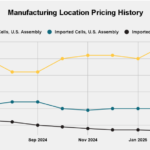What the Latest Rate Dip Means for Small Carriers (Part 2)
The freight recession is dragging on and getting deeper as tariffs throw a wrench into any possible recovery. What does this mean for small carriers? The post What the Latest Rate Dip Means for Small Carriers (Part 2) appeared first on FreightWaves.

Let’s not sugarcoat it—rates are slipping again.
If you’re a small carrier, you probably don’t need another graph, another report, or another freight economist telling you what you already feel in your wallet. You feel it when you bid a lane and get undercut by someone running for fuel money. You feel it when you see a load at $1.75 per mile and you’re wondering, “Who in their right mind is moving freight this cheap?”
This isn’t new. But this—this right now—is a different kind of rate dip. And if you’re still running your business like it’s 2022, you’re going to get wiped out in 2025.
This is Part 2 of a conversation we need to keep having. Because too many small carriers are treating rate dips like weather—hoping it’ll just pass. What you need to understand is that this market shift isn’t just a blip. It’s a pressure test. And only those with sound fundamentals are going to survive.
Let’s break down what’s happening, what it actually means for you, and most importantly—what to do about it.
A Market Rebalancing, or a Market Reset?
Let’s talk facts.
Rates have dipped 14% year-over-year in key dry van markets. Reefer isn’t doing much better. Spot market loads are down. Contract freight is getting tighter. And meanwhile, operating costs haven’t dropped—they’ve risen. Insurance is up. Fuel, while slightly down from last year, is still volatile. And maintenance costs have spiked due to parts delays and labor shortages.
Now, the big question I get from small carriers is:
“Adam, is this just a correction… or is this the new normal?”
The honest answer? It’s both.
We’re seeing a market rebalancing—yes. Capacity surged after 2020. Everyone and their cousin bought a truck, got their MC number, and hit the road with stars in their eyes. But now, those who entered with emotion instead of strategy are exiting with regret.
This rate dip is the industry’s way of clearing the board. It’s not personal, it’s math.

Why This Dip Hits Small Carriers Harder
Larger carriers have scale. They’ve got rolling contract freight. They’ve got direct shipper relationships. They’ve got fuel surcharge programs, better insurance leverage, maintenance programs, and in some cases, their own freight.
You?
You might have one truck. Maybe three. Maybe you’re juggling payroll while fielding cold calls. You’re running spot freight to make ends meet. You’re the dispatch, the driver, the mechanic, and the customer service team all in one.
So when rates fall 20 cents, that doesn’t just trim your profit margin—it wipes it out.
Here’s where it gets dangerous:
- You start chasing miles instead of chasing margin
- You compromise on your minimum RPM
- You burn more fuel on deadhead than you do on loaded miles
- You start paying yourself last—if at all
And if that sounds familiar, you’re not alone. But it’s not sustainable.
The Bottom Line: Know Your Numbers or Lose Your Business
If I could give you a tattoo that wraps around your forearm so you’d see it every day, it would say:
“Revenue is vanity. Profit is sanity. Cash flow is reality.”
In a rate dip, your survival is directly tied to one thing: your understanding of your numbers.
Do you know your:
- Break-even RPM (per truck)?
- Cost-per-mile (with and without fuel)?
- Revenue-per-hour of service?
- Fixed cost threshold per week?
If you’re using Playbook’s Operating Calculator, you’ve already got access to tools like the built-in Breakeven Calculator. Use it. Live in it. Let it be your first and last check before booking a load.
I can’t tell you how many carriers I’ve coached who thought they were doing well—until we ran the numbers. That $2,800 load from Atlanta to Denver? After fuel, time, tolls, and deadhead back, they were working for less than minimum wage.
In a volatile market, numbers tell the truth even when the market lies.
What to Do Right Now if You’re Feeling the Squeeze
If you’ve read this far, you’re not the type to bury your head in the sand. So let me give you some real, practical things you can do starting this week:
1. Build a Weekly Financial Scorecard
Track these every week without fail:
- Revenue per mile
- Revenue per day
- Deadhead percentage
- Fuel cost per mile
- Gross margin per load
This isn’t busywork—it’s your business heartbeat. Know when it skips.
2. Get Aggressive with Direct Freight
Spot freight is like fishing in a pond where everyone else already dropped bait.
Direct freight is your lifeline. If you’re not making 5 cold calls a day to shippers, you’re leaving money—and stability—on the table.
Start with:
- Warehouse managers at smaller distribution centers
- Local manufacturers
- Packaging companies
- Produce vendors if you’re running reefer
Use your local knowledge to your advantage.
3. Stop Running for the Sake of Running
This one’s hard to hear. But every mile you run below your break-even is a mile you’re paying to be in business.
Park the truck if the rate’s not right. Period. Better to live another week than run yourself into the red for pride.
4. Renegotiate Fixed Expenses
Your insurance, factoring, trailer rental, ELD subscription—go back to every vendor and ask for a better rate. Loyalty is great when times are good. But when it’s tight, it’s time to sharpen the pencil.
5. Lean Into Community and Coaching
You shouldn’t be navigating this alone. Get with a mentorship program, join roundtables, attend webinars, and plug into content that shows you what others are doing. You’ll be surprised how much game you pick up from being in the right rooms.
A Quick Word on Spot Market Addiction
Some of y’all are out here treating load boards like it’s the Gospel.
Listen, load boards are a tool, not a strategy. And when the spot market dries up, so does your plan if that’s all you rely on.
A rate dip should force you to pivot your model—not panic.
You don’t need to chase rates. You need to create lanes.
Start by:
- Mapping out your ideal triangle routes
- Identifying weekly recurring loads
- Offering consistent availability to small brokers
The ones who win in a market like this are the ones who stop playing checkers and start playing chess.
If You’re New to the Industry
If you got your authority in the last 18 months and this is your first major dip, welcome to the proving ground.
You’re not crazy. You didn’t make a mistake getting into the business. But you do need to unlearn the “boom year” behaviors.
It’s time to:
- Tighten up your business fundamentals
- Stop accepting every load just to stay moving
- Think like a business owner, not just a truck driver
Remember: Your authority doesn’t make you a carrier. Your margin does.
The Opportunity Inside the Dip
Let me leave you with this.
Rate dips—while painful—are filters.
They separate the folks who hustled in without a plan from the ones who are willing to do the work to build a foundation. The real opportunity in this dip is learning what you’re made of—and building a business that can weather any storm.
I’ve seen people with one truck and no dispatch team land dedicated freight because they were persistent, professional, and strategic. I’ve seen operators double their profit by simply understanding how to say no.
And I’ve also seen people disappear because they waited too long to adapt.
Don’t let that be you.
Final Word
This market ain’t for the faint of heart. But neither are you.
Use this dip as a wake-up call, not a death sentence. Get your numbers right. Focus on margin. Learn how to sell. And most importantly, run your business like a business.
Because the carriers that survive this cycle? They’re the ones who’ll own the next one.
The post What the Latest Rate Dip Means for Small Carriers (Part 2) appeared first on FreightWaves.
























































































































































